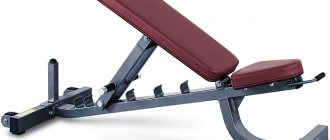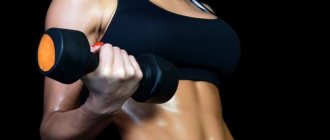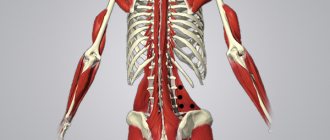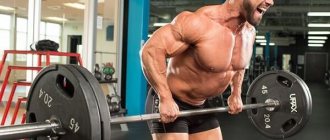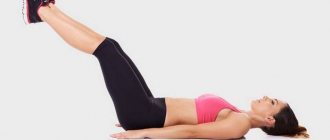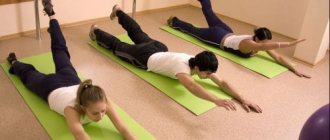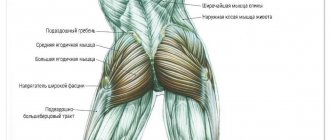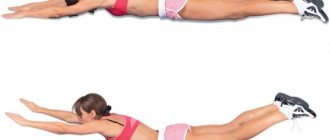A strong neck is, first of all, a necessity, and only secondarily a beauty. The neck consists of more than 15 muscles and each of them is of great importance, because thanks to the neck we not only move our heads, but also breathe, speak and swallow normally. It is important to protect the neck from injuries that we can get while playing sports, or from complications that, on the contrary, entail a sedentary lifestyle and incorrect mechanics of everyday movements. Let's look at exercises on how to pump up your neck muscles in the video.
- Why train your neck?
- Muscle pumping for health
- For comfort
- Pump your neck for safety
- Muscle training for athletic performance and strength
- Shake your neck for beauty
- What muscles are involved in the exercises?
- Contraindications and precautions (including osteochondrosis)
- How to stretch your neck at home
- Trapezius stretch
- Video: Trapezius stretch
- Tilts the head back and forth
- Tilts of head to shoulders
- Circular movements of the head
- Effective exercises for overcoming resistance
- Extension
- Flexion
- Lateral neck flexion
- Video: Neck Exercises with Resistance
- The Best Bodyweight Exercises to Build Mass
- Face down bridge for wrestlers
- Bortsovsky bridge face up
- Exercise "Rolls"
- Video: Bortsovsky Bridge and rifts
- Exercises with weights
- Neck curls with weights (dumbbell, disc or medicine ball)
- Standing neck extensions with a special device - belt
- Neck extensions lying on a bench
- Video: Exercises for the neck with weights, flexion and extension
- Side bends with weight
- Video: Neck bends to the side with weight
Why train your neck?
Our neck not only connects our head to the rest of our body, but also performs vital functions:
- The most important supply routes for the body pass through the neck: blood vessels, larynx, esophagus, trachea;
- the spine and neck muscles support the position of the head;
- neck muscles are involved in such important processes as swallowing and pronouncing sounds.
The neck muscles are divided into two large groups:
- Intrinsic or deep muscles: These help flex the head and body. These include the longus colli muscle and the longus capitis muscle.
- Participate in breathing by raising the ribs and bending the neck: the anterior, middle and posterior scalene muscles.
- The movement of the larynx is influenced by: the sublingual group (sterno-, scapular-, thyroid-, mental-) and the sternothyroid.
- Affect the movement of the larynx and lower jaw: digastric, mylohyoid, stylohyoid.
For what purposes do we train the neck?
Muscle pumping for health
If the neck muscles are not toned, our posture worsens and our back appears slouched. Often headaches are caused by poor blood supply to the brain - this is also affected by the muscles of the neck, which for one reason or another can be under constant strain, pinching nerves and blood vessels. By doing simple neck exercises several times a week, you can improve your well-being and performance.
For comfort
When we are stressed, our trapezius muscle contracts. This is a natural protective reaction of the body: this is how we gather our strength, roughly speaking, we prepare for battle. But it happens that the stress passes, but the tension in the neck remains. The paradox is that the weaker our muscles are, the worse stress affects them, the more they hold tension. At the same time, strong, developed muscles, on the contrary, easily relax. In addition, strengthening your neck muscles reduces stress from sitting at a desk for long hours.
Pump your neck for safety
Developed neck muscles can serve as a so-called airbag not only for athletes. And in ordinary life, anything can happen. The benefits of a strong neck have been proven more than once by accidents with athletes, whose neck muscles reduced the degree of concussion and prevented vertebral fractures. Obviously, this function of the neck is simply necessary for wrestlers and boxers.
Muscle training for athletic performance and strength
Strong neck muscles stabilize the thoracic spine. Thanks to this, athletes lift more weight in deadlifts, squats, and standing presses. And in football you can take the ball with your head. It's scary to imagine what could happen to the neck if an untrained person does this.
Shake your neck for beauty
If you are engaged in your physical fitness, you need to take care of every part of the body, including for the sake of aesthetics. Imagine a bodybuilder with a voluminous chest and impressive arms, but an insufficiently developed neck - the look is not very harmonious.
Neck muscle training[edit | edit code]
Anatomy of the neck muscles Gymnastics and exercises for the neck
It is difficult to overestimate the importance of the neck muscles, both from an aesthetic point of view and from the point of view of benefits in sports.
In order to look at your feet or up, to the side or just look back, you always need to turn your neck. In many types of wrestling, you can’t achieve anything without a developed neck; in a standing position there are constant neck grabs, on the ground, on a wrestling bridge, you often have to hold both your weight and the weight of your opponent. In martial arts, the neck muscles absorb blows from the enemy to the face and head. Finally, the neck is the only muscle group that is always visible, in any clothing and in any weather. Developed neck muscles are simply beautiful. Considering that most people work sedentarily at a computer, neck training helps prevent cervical osteochondrosis and pain. Unfortunately, many bodybuilders neglect training the neck muscles, giving preference to other muscle groups. Almost all training programs do not contain neck exercises. The result is a clear imbalance in the development of different muscle groups, which negatively affects the overall assessment of athletes. Read the main article:
Neck muscles
What muscles are involved in the exercises?
The neck muscles are indirectly involved in training aimed at working the back and shoulders. But you can achieve neck development faster by performing exercises aimed at specific muscles:
- trapezoidal;
- sternocleidomastoid;
- hyoid bone: digastric, maxillary-hyoid, stylohyoid, sternohyoid, scapular-hyoid, sternothyroid, thyrohyoid, geniohyoid.
These muscles are used in neck exercises
Preparatory stage
The neck muscles are very easily injured, so before starting serious training, it is necessary to do a preparatory warm-up. This will help warm up the desired area and prevent sprains. The most suitable exercises include the following:
- Head tilts. Bend your head forward, trying to lower your chin to your chest as low as possible, and then back, tilting your head as far as possible.
- Turns. Turn your head left and right, trying to touch your ears to your shoulder.
- Rotations. Turn your head left and right.
- Circular rotations. tilt your head slightly to the right side and twist in a circle, first down, then to the left and forward.
- To warm up the side muscles of your neck, raise your arm up, bend it at the elbow and reach towards your ear on the opposite side. Switch hands.
- For the front group of neck muscles, clasp your fingers and place them on the back of your head. While holding your head, bend backwards.
- For the posterior muscle group, place your palms on your forehead and try to bend forward.
All exercises must be performed at a slow, relaxed pace; in no case should you make sudden movements or speed up. Failure to follow simple safety rules can lead to very severe pain and will discourage you from going to the gym for a long time.
Do 5-7 repetitions, feeling the tension and tension in your muscles as you perform. Warm-up should last 3-5 minutes. Then you should begin strength training.
Contraindications and precautions (including osteochondrosis)
The neck is one of the most vulnerable places in a person. It can be injured without even playing sports. Before you start training your neck, you must be sure that you have no contraindications for this:
- You should not put any strain on your neck if you have appropriate contraindications from your doctor;
- if you have had injuries to the spine or neck muscles (for example: osteochondrosis), then you also need to consult a doctor before starting training; most likely, you will have to choose exercises very carefully and perform them carefully, avoiding unnecessary stress;
- if you have a sedentary lifestyle, you haven’t exercised for a long time or are far from sports at all, then your neck is too weak to withstand heavy loads; in this case, you should not exercise with weights, but it is better to do a simple warm-up several times a week, at least at first;
- If you already have experience in sports, but have never trained your neck, you should start with light weights.
If you decide to pump up your neck, and you have no contraindications for this, nevertheless, observe the following precautions:
- start your workout with a warm-up, and at the end don’t forget to do a few final stretching and relaxation exercises;
- the correct choice of loads is important, since heavy weight can cause serious injury;
- you need the right equipment: a special head strap, a soft covering under your head or a towel;
- The correct technique for doing the exercises is important, otherwise there is a risk of damaging the cervical vertebrae;
- Do not exceed the number of recommended approaches and repetitions, otherwise you also risk injury;
- all exercises must be performed without sudden movements, smoothly;
- During the exercises, monitor your sensations, stop the exercise if you feel pain.
Do I need to download it?
Before answering the question of how to properly pump up your neck, let’s find out for whom this is generally advisable.
Targeted pumping of the neck muscles is not common. We are not talking about physical therapy exercises, but about the additional development of the muscles in this area.
A strong neck is usually needed by wrestlers. Bodybuilders usually do not pay special attention to this part of the body. And this is primarily due to the danger of damaging the spine.
The cervical spine is the most fragile, mobile and weakest place in our spinal column. Damage to it will lead to consequences of varying severity. And it’s very easy to damage your neck – just take too much weight.
If strengthening your neck muscles is important to you, then I'll tell you how to do it safely. But first, pay attention to those points in the presence of which neck training should be limited only to exercise therapy exercises.
How to stretch your neck at home
All strength exercises for pumping up mass must be done after warming up. At the same time, it is useful to perform the warm-up itself every day and as a separate complex at home, which can be performed without any exercise equipment.
Trapezius stretch
The trapezius muscle runs from the back to the neck. She is responsible for tilting and turning her head; it is very important to prepare her for training:
- Place your right hand on the back of your head, slightly to the left.
- Tilt your head forward in the direction of movement of your hand, that is, diagonally to the right and down.
- Stay in this position for 20 seconds.
- Repeat on the other side.
- Do 2-3 approaches.
The video shows how to properly pump your neck to increase muscle size.
Video: Trapezius stretch
Tilts the head back and forth
The amplitude should be small: do not throw your head back too much, so as not to injure the vertebrae and not to compress the nerves and blood vessels.
- As you exhale, tilt your head forward without changing the position of your back. Gently pull your chin towards your chest.
- As you inhale, tilt your head back, pull your chin as high as possible, keep your shoulders down. Stay in the bend for 2 seconds and return to the starting position.
- Do 6-10 reps.
Tilts of head to shoulders
Try not to reach your lower ear toward your shoulder, but your upper ear toward the ceiling.
- As you exhale, tilt your head to the side so that your ear moves towards your shoulder.
- As you inhale, return to the center.
- Exhale and repeat on the other side.
- You can help yourself with your hand.
- Do 6-10 repetitions, holding each side for a couple of seconds.
In the last bend on each side, you can linger a little longer by placing the palm of the opposite hand on your upper ear. The pressure can only be very soft and pleasant; there should be no discomfort and, especially, pain under any circumstances.
Circular movements of the head
Slowly and smoothly make 4-8 circular movements with your head, first in one direction, then in the other. When the movement goes up, inhale; when down, exhale. Do not forget that the amplitude should be small and comfortable.
Head tilts back and forth, side bends, rotations
When not to do physical therapy
It is prohibited to engage in therapeutic exercises for osteochondrosis in the following cases:
- severe pain in the neck-shoulder region, which does not go away even in a calm state;
- vertebral instability, which appears due to impaired blood microcirculation. In this case, a person often experiences dizziness;
- instability of the cervical vertebrae, which can be seen in the image;
- acute phase of chronic diseases (appendicitis, cholecystitis, hepatitis, intestinal and cold infections);
- oncological processes;
- heat;
- intervertebral hernia or protrusion. If this pathology is suspected or present, consultation with a specialist is necessary;
- hypertension - high blood pressure.
Important! Minor pain in acute cervical osteochondrosis is not a ban on exercise therapy, although some doctors have the opposite opinion. Only the attending physician can say for sure whether it is possible to engage in physical therapy for moderate pain.
Effective exercises for overcoming resistance
The neck complex for overcoming resistance is suitable for beginners and includes three main exercises: extension, flexion and lateral movement.
Extension
We will need sports tape or a regular towel.
- Place the tape at the back of your head and hold both ends in your hands.
- Tilt your head forward slightly.
- Pull the band forward by the straps and, as you exhale, resist the pressure, feeling how the back of your neck works. As you inhale, release the load.
- Perform the exercise by alternately loading your neck and removing the load: 4-5 seconds - pressure, then the same amount - rest.
- Do 10 of these repetitions.
1
Flexion
An exercise for pumping, which should definitely be performed in combination with the previous one, otherwise the neck will receive a disharmonious load.
- Sit or stand straight, stretch your neck, straighten your shoulders.
- Place the heels of your palms above your eyebrows and tilt your chin slightly down.
- As you exhale, press your hands on your forehead, and your forehead on your hands, feeling how the front surface of your neck works.
- As you inhale, stop pressing and resisting the pressure.
- Perform 10 reps, alternating between 4-5 second pressure and rest periods.
1
Lateral neck flexion
In this complex, it remains to use the sides of the neck.
- Place your palm on the side of your head so that your fingers point towards the back of your head. The base of the palm is located at the top of the cheekbone and the outer corner of the eyebrow. The elbow points straight to the side.
- As you exhale, we begin to press our hand on our head, and our head on our hand. Please note that the head movement is to the side, and not down to the shoulder.
- As we inhale, we relax.
- Perform 10 repetitions, alternating 4-5 second periods of pressure and rest.
1
You can train your neck in this way once every 3 days, but it will be useful to repeat the complex at least every day when you have a few free minutes.
Video: Neck Exercises with Resistance
Benefits of a toned neck
Knowing what types of neck muscles there are and how to pump them up is important. But why is this necessary?
- BEAUTY AND AESTHETICS. One of the first advantages is beauty. After all, if a bodybuilder has a pumped up body, but a shapeless neck, it will not look aesthetically pleasing. A neck with a beautiful relief attracts attention and speaks of the discipline and endurance of the athlete. This is also important for women; naturally, there is no need to overdo it in this matter. If you constantly do exercises that work this area, you can forget about sagging and sagging skin, a double chin and premature aging. Also, with a beautiful, sculpted neck, the décolleté area will look even more impressive.
- HEALTH. Working out the neck muscles has a very beneficial effect on health and well-being. A strong neck reduces the risks of osteochondrosis, high blood pressure, neurological diseases, and also relieves fatigue and tension.
- Athletes involved in CONTACT SPORTS must strengthen their neck muscles. Otherwise, this can lead to injuries, including concussions, and losses in competitions.
- For people involved in bodybuilding, a strong neck is a SUPPORT in many exercises, especially with a barbell.
Now let's find out how to prepare your neck for a serious workout.
The Best Bodyweight Exercises to Build Mass
Bodyweight exercises are already a challenge. An unprepared person risks injuring his neck by starting with them, and they are contraindicated for “owners” of injuries and any problems with the spine.
Face down bridge for wrestlers
The wrestling bridge is considered the most effective exercise for developing the neck; it includes many variations and can be performed in both static and dynamic forms.
To perform a face-down wrestling bridge, do the following:
- Stand up, bend over and, helping yourself with your hands, rest your head on the floor. It is important that there is a soft covering on the floor, such as a towel.
- Do not remove your palms from the floor if you are not confident in your abilities. It’s better to try this option first and only after a few workouts try to put your hands behind your back.
- Next, in this position, do the exercises already familiar to you from the warm-up for 15–20 repetitions:
- flexion-extension of the head;
- tilting the head from side to side;
- head rotation.
- Do 2-3 approaches.
The lower the bridge, the greater the load on the head and abdominal muscles
Bortsovsky bridge face up
The second version of the bridge, somewhat more similar to the usual bridge from gymnastics.
- Lie on your back, place your palms near your shoulders with your fingers facing you, bend your knees.
- As you exhale, arch your back and stand on a regular bridge with support on your palms and feet.
- Bending your elbows, smoothly lower yourself to the back of your head, gradually remove your arms, and you can fold them on your chest.
- In this position, do 2-3 sets of 15-20 rolls from the crown to the back of the head.
- Don’t do rolls if you have difficulty standing on your head without your hands, first just try to fix this position for a comfortable time.
1
Exercise "Rolls"
“Rolls” or “runs” are the third option for neck exercises with your own weight, which is suitable only for experienced practitioners. This is a dynamic combination of two wrestling bridges: face up and face down.
- Stand in a wrestling bridge face down.
- Fix your head in one position and start moving around it in any direction. Your head and arms remain in place, and with your legs you go around or “run around” your head in a circle. In this case, half of the circle you are in the bridge face down, and the other half - face up.
- Do 10–12 of these rolls in each direction.
Video: Bortsovsky Bridge and rifts
Gymnastics according to Gitt
Popular chiropractor Vitaly Demyanovich Gitt has developed special exercises for the treatment of osteochondrosis using micromotor techniques. Exercises should be done 5-10 times a day to achieve good results.
- Sit down comfortably. Shake your head back and forth as if you are confirming something. Perform the exercise continuously for 2 minutes. After this, a break of 20 minutes.
- Shake your head in the same position, but as if you are denying something. Perform this action for a couple of minutes.
The most important thing is that the range of movements is small.
Continuous performance of this set of exercises will improve the condition of the spine and normalize metabolism in tissues. In some cases, Gitta exercises will help you cope with common forms of osteochondrosis, but this may take years.
Exercises with weights
Weight training will make your neck muscles truly strong. But you need to start with light weights; two workouts a week will be enough. If you are already doing a great job with bodyweight training without helping yourself with your arms, then you can move to the next level.
The methods here are the same as in the previous complexes: the neck needs to be bent, straightened and tilted to the sides.
Neck curls with weights (dumbbell, disc or medicine ball)
To do the exercise:
- Lie on a bench with your back, take a weight, place it on your forehead, holding it with your hands. For comfort, you can add a towel.
- You can use a light dumbbell or medicine ball as weight.
- As you inhale, tilt your head back about 45 degrees.
- As you exhale, lift your head, bringing your chin closer to your chest.
- Do 3-4 sets of 12-15 reps.
1
Standing neck extensions with a special device - belt
To pump up your muscles with this exercise, you will need a special device - a head strap (helmet or hat).
- Take a belt, attach a small weight to it and put the belt on your head (photo).
- Place your feet shoulder-width apart, knees soft. Straighten your back and tilt your body slightly forward. For convenience, you can rest your palms on your knees.
- As you exhale, gently tilt your head forward, and as you inhale, return to the starting position.
- Do 3-4 sets of 12-15 reps.
This exercise requires a special head strap
Neck extensions lying on a bench
If you don't have a head strap, do the same exercise while lying on a bench:
- Lie face down on a bench, take a small weight (a barbell plate or medicine ball) and place it on the back of your head, holding it with your hands.
- Perform head tilts down and extensions to a horizontal position. No need to lift your head up.
- Do 3-4 sets of 12-15 reps.
1
Video: Exercises for the neck with weights, flexion and extension
Side bends with weight
For this exercise, it is advisable to take less weight than in previous exercises:
- Lie on a bench on your side, take a light weight.
- Tilt your head with the weight down no more than 45 degrees, then lift it up, trying to reach your ear with your shoulder.
- Do 3-4 sets of 12-15 reps.
11
You can place a towel under the weight for hygiene and greater comfort.
Video: Neck bends to the side with weight
Training the neck muscles will be useful for both athletes and people far from sports. It will only bring benefits, allowing you to stretch and strengthen your muscles. Don't want to spend a lot of time and effort on classes? Do one warm-up - if you are not chasing sports results, only this will give a noticeable effect and improve your well-being. Want a mighty neck from scratch? Start with simple resistance exercises, and within a month you will move on to bodyweight exercises. With proper persistence, in just a few months you will qualitatively pump up your neck muscles.
Warm-up
Before loading your neck, you need to warm up your neck muscles and joints.
- To do this, stand up straight with your feet shoulder-width apart. Leave your hands on your belt. Some people may feel dizzy during exercise. Therefore, be careful.
- Tilt your head all the way to the right, then to the left. Slowly.
- Rotate your head clockwise and back. Again, do everything slowly. When you rotate your head, try to draw a circle with the maximum radius.
- Another great exercise is to draw a huge figure eight with your nose in the air. The movement is difficult, so it warms up the neck perfectly.
Spend at least 2-3 minutes warming up. And never start working with cold muscles.

